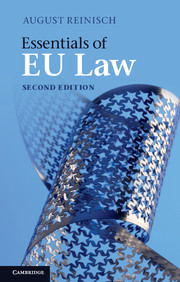Book contents
- Frontmatter
- Contents
- Preface
- Abbreviations
- 1 History of European integration
- 2 The institutional framework
- 3 The making of Union law
- 4 The effect of Union law
- 5 Judicial control within the Union
- 6 Protecting fundamental rights within the EU
- 7 The free movement of goods
- 8 The free movement of persons
- 9 EU competition law
- 10 Selected EU policies
- 11 The EU as an international actor
- Index
6 - Protecting fundamental rights within the EU
Published online by Cambridge University Press: 05 November 2012
- Frontmatter
- Contents
- Preface
- Abbreviations
- 1 History of European integration
- 2 The institutional framework
- 3 The making of Union law
- 4 The effect of Union law
- 5 Judicial control within the Union
- 6 Protecting fundamental rights within the EU
- 7 The free movement of goods
- 8 The free movement of persons
- 9 EU competition law
- 10 Selected EU policies
- 11 The EU as an international actor
- Index
Summary
The initial Community Treaties establishing the ECSC, the EEC and EURATOM did not contain any fundamental rights provisions at all. The 1953 Draft Treaty embodying the Statute of a European Political Community envisaged human rights protection as a major task and proposed to incorporate the European Convention on Human Rights (ECHR), a treaty concluded by many European states in 1950 under the auspices of the Council of Europe and enforced by the European Court of Human Rights (ECtHR) in Strasbourg. After the plans for a European Defence Community were buried by the French National Assembly in 1954, this idea also became obsolete. With the resurgence of the ‘functionalist approach’, culminating in the 1957 Rome Treaties, the view prevailed that the economic integration now pursued did not warrant the inclusion of human rights guarantees.
With the growth of the activities of the European Union, however, the likelihood of infringement of fundamental rights also increased. Clearly, the extension of Union law into many fields beyond the core aspects of the four freedoms was not a wholly unintended ‘spill-over effect’ of economic integration. This tendency was reinforced by the specific development of EU law, in particular of direct effect and primacy in such landmark cases as Van Gend en Loos and Costa v. ENEL. Both direct effect and primacy increase the probability that it is EU law itself and not any national implementation that may infringe human rights.
- Type
- Chapter
- Information
- Essentials of EU Law , pp. 99 - 120Publisher: Cambridge University PressPrint publication year: 2012

